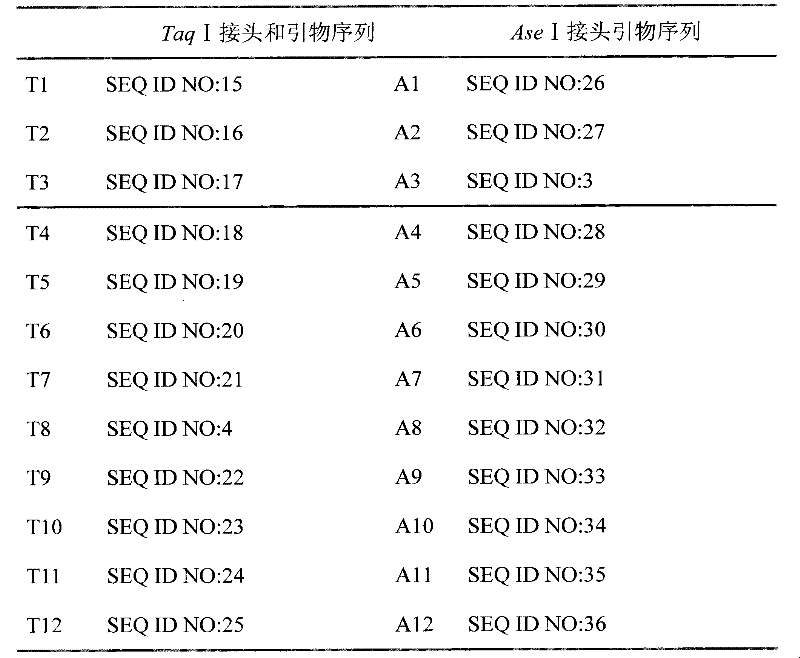Anti-plant-bacterial-wilt gene, preparation method and application thereof
A bacterial wilt and bacterial wilt resistance technology, applied in the field of plant disease resistance, can solve the problems of bacterial wilt disease encroaching on the environment, pollution, narrow genetic basis, etc. Effect
- Summary
- Abstract
- Description
- Claims
- Application Information
AI Technical Summary
Problems solved by technology
Method used
Image
Examples
Embodiment 1
[0022] Example 1 Preparation of disease resistance gene
[0023] 1. For the materials used (E-31, E-32 and their F1 and F2 generation plants), carry out artificial anti-bacterial wilt resistance identification by root irrigation method, and determine the disease-resistant materials and disease-susceptible materials.
[0024] 2. The total RNA of the disease-resistant material E-31, the disease-resistant material E-32 and their F1 and F2 generations of disease-resistant plants and susceptible plants was isolated and extracted by the Trizol method.
[0025] 3. Synthesis of cDNA
[0026] Double-stranded cDNA synthesis protocol refers to SMART of CLONTECH company TM cDNA Library construction kit Manual. Among them, Powerscript Reverse Transcriptase was purchased from Invitrogen Company, and 50×advantage 2 polymerase Mix was purchased from CLONTECH Company. cDNA Synthesis (CDS), SMARTП primer and 5′-PCR primer were synthesized by Shanghai Sangong. The SMARTП sequence is shown in...
Embodiment 2
[0151] Example 2 Method for introducing genes into plants
[0152] Digest pMD19-T containing the target gene with sma I and sac I to cut out the target gene, then also use sma I and sac I to double digest the GUS gene of pBI121, and use T4 ligase to digest the disease resistance gene with the restriction enzyme After connecting pBI121 at 16°C for 12 hours, the sense plant expression vector pBI121-RE-bw of the disease resistance gene can be obtained, and the constructed plant expression vector can be transformed into Agrobacterium EHA105 or LBA4404 by freeze-thaw method, and genetic transformation can be carried out .
[0153] Taking the susceptible eggplant inbred line "E-32" as the transformation material, the specific genetic transformation method mediated by Agrobacterium was introduced. The specific operation method is: cultivate aseptic seedlings of eggplant, cut off the epicotyl of 7d seedling age, soak in 600 0.5 Agrobacterium bacteria liquid for 13 minutes, dry the e...
Embodiment 3
[0155] Example 3 Evaluation of the disease resistance of the transgenic plants obtained
[0156] The transgenic contemporary plants are planted in the field, and the incidence rate is less than 20%. The symptoms of the diseased plants are 1-2 (that is, the whole plant has 1-3 withers), while the incidence rate of the control (transformed plants) is more than 80%. , the symptoms of the diseased plants showed 4-5 grades (that is, the leaves of the whole plant were withered or even died); the transgenic plants were artificially inoculated for bacterial wilt identification, and the onset time was delayed by 15 days compared with the control plants, while the control plants showed symptoms 7 days after inoculation. Symptoms of infection. The disease index of the transgenic plants was 8.74, and the group resistance was resistant, while the disease index of the control plants was 76.68, and the group resistance was high.
PUM
 Login to View More
Login to View More Abstract
Description
Claims
Application Information
 Login to View More
Login to View More - R&D
- Intellectual Property
- Life Sciences
- Materials
- Tech Scout
- Unparalleled Data Quality
- Higher Quality Content
- 60% Fewer Hallucinations
Browse by: Latest US Patents, China's latest patents, Technical Efficacy Thesaurus, Application Domain, Technology Topic, Popular Technical Reports.
© 2025 PatSnap. All rights reserved.Legal|Privacy policy|Modern Slavery Act Transparency Statement|Sitemap|About US| Contact US: help@patsnap.com

